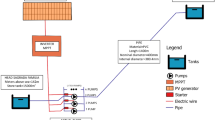Abstract
The aim is to fill a water storage with potable water of a given quality, for subsequent treatment and distribution to a water conveying system. During a given period, a set of several pumping stations is working to deliver water from different sources at different locations. A multi-stage control process is considered whereby the total pumping time is divided into short sampling intervals. The intensity of pumping as a function of time is the control variable. It is assumed that there exists a reliable forecast of every pollutant as a function of time and water source. The amount of the pollutants are constrained in the final mass of water in the storage. The mass of water at the end of the operation period should be maximized. A linear programming (LP) model of the problem is described, and an algorithm of the reduction of its dimensionality is presented. An illustrative example is shown.
Similar content being viewed by others
References
Adriaanse, M., Niederlander, H. A. G., & Stortelder, P. B. M. (1995). Monitoring water quality in the future. Chemical Monitoring. Ministry of Housing, Spatial Planning and the Environment. Department for Information and International Relations, 1. The Netherlands: The Hague.
Booty, W. G., Wong, I. W. S., Lam, D. C. L., Kerby, J. P., & Kay, D. F. (1993). Application of an expert system for point source water quality modelling. In: G. Guariso, & B. Page (Eds.), CSEIA 93, Computer support for environmental impact assessment (pp. 233–244) Como, Italy: Elsevier.
Brearly, A. L., Mitra, G., & Williams, H. P. (1975). Analysis of mathematical programming problems prior to applying the simplex algorithm. Mathematical Programming, 8, 54–83.
Cormen, T. H., Leiserson, R. L., & Rivest, R. L. (1990). Introduction to algorithms. Cambridge, MA, USA: MIT Press.
Dantzig, G. B. (1963). Linear programming and extensions. Princeton University Press, Princeton, NJ, USA.
Gardner, J. W., Shin, H. W., Hines, E. L., & Crawford, S. D. (2000). An electronic nose system for monitoring the quality of potable water. Sensors and Actuators B 69, 336–341.
Gill, P. E., Murray, W., & Wright, M. H. (1991). Numerical linear algebra and optimization, vol. 1, p. 426. Redwood City, CA: Addison-Wesley, Advanced Book Program.
Gould, N., & Toint, P. L. (2004). Preprocessing for quadratic programming. Mathematical Programming, 100(1), 95–132.
Guariso, G., & Werthner, H., (1989). Environmental decision support systems (p. 240). Ellis Horwood Series in Computers and their Applications. Chichester: Ellis and Horwood.
Gutman, P.-O. (1986). A linear programming regulator applied to hydroelectric reservoir level control. Automatica, 22, 533–554.
Gutman, P.-O., Lindberg, P.-O., Ioslovich, I., & Seginer, I. (1993). A non-linear optimal greenhouse problem solved by linear programming. Journal of Agricultural Engineering Research, 55(4), 335–351.
Hendriks, A. J., & Pieters, H. (1993). Monitoring concentrations of microcontaminants in aquatic organisms in the Rhine delta: A comparison to reference values. Chemosphere, 26, 817–836.
Ioslovich, I. (1999). Numerical software for redundancy determination and presolving analysis of large scale linear programming problems, using Matlab 5.2. Proceedings, Second NICONET Workshop: Numerical Control Software (pp. 67–71). Rocquencourt, France: INRIA.
Ioslovich, I. (2001). Robust reduction of a class of large-scale linear programs. SIAM Journal on Optimization, 12, 262–282.
Ioslovich, I. V., & Makarenkov, Y. M. (1975). On methods of dimensionality reduction in linear programming. Economics and Mathematical Methods, Moscow. 11(3), 316–324 (in Russian).
Karwan, M. H., Lofti, F., Telgen, J., & Zionts, S. (1983). Redundancy in mathematical programming (p. 285). Berlin: Springer.
Luiten, J. P. A., & Groot, S. (1992). Modelling quantity and quality of surface waters in The Netherlands: Policy analysis of water management for The Netherlands. European Water Pollution Control, 2, 23–33.
Organization of Economic Cooperation and Development (OECD) (1993). OECD guidelines for testing of chemicals, vol. 1, 201–207. Paris, France.
Ouyang, Y. (2005). Evaluation of river water quality monitoring stations by principal component analysis. Water Research, 39, 2621–2635.
Propoi, A. I. (1963). Use of LP methods for synthesizing sampled-data automatic systems. Automation and Remote Control, 24, 837–858.
Richardson, M. (1995). Environmental toxicology assessment. London: Taylor and Francis.
Robinson, R. M. (1989). Environmental impact assessment: The growing importance of science in government decision making. Hydrobiologia, 188, 137–142.
Rogers, D. F., Plante, R. D., Wong, R. T. & Evans, J. R. (1991). Aggregation and disaggregation techniques and methodology in optimization. Operations Research, 39(4), 553–558.
Sahooa, G. B., Raya, C., Wangc, J. Z., Hubbsc, S. A., Songc, R., Jaspersed, et al. (2005). Use of artificial neural networks to evaluate the effectiveness of riverbank filtration. Water Research, 39, 2505–2516.
Silvert, W. (1989). Modelling for managers. Ecological Modelling, 47, 53–64.
Van der Gaag, M. A. (1991). Setting environmental quality criteria for water and sediment in The Netherlands. A pragmatic ecotoxicological approach. European Water Pollution Control, 1, 13–20.
Vrijhof, H. (1984). The selection of priority black-list substances for the river Rhine and waters of the European community. Water Science and Technology, 16, 525–528.
WHO (World Health Organization) (1993). Guidelines for drinking-water quality (2nd ed.), vol. 1, Recomendations. Geneva: World Health Organization.
Zwart, D., & Folkerts, A. J. (1990). Monitoring the toxicity of organic compounds dissolved in Rhine water. Hydrobiological Bulletin, 24, 5–12.
Author information
Authors and Affiliations
Corresponding author
Additional information
A short conference version of this paper has been presented at 14th IEEE Mediterranean Conference on Control Automation, June 28–30 2006, Polytechnical University of Ancona, Ancona, Italy.
Rights and permissions
About this article
Cite this article
Ioslovich, I., Gutman, PO. Optimal monitoring and management of a water storage. Environ Monit Assess 138, 93–100 (2008). https://doi.org/10.1007/s10661-007-9745-8
Received:
Accepted:
Published:
Issue Date:
DOI: https://doi.org/10.1007/s10661-007-9745-8




